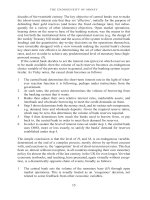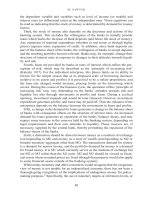Differentiate similarities and differences between strategy and strategic management in operation of an organization
Bạn đang xem bản rút gọn của tài liệu. Xem và tải ngay bản đầy đủ của tài liệu tại đây (209.44 KB, 10 trang )
Differentiate similarities and differences between Strategy and Strategic
Management in operation of an organization/enterprise.
Task:
Concept of strategy and strategic management have many similarities and
differences, to differentiate them, first of all, we should clarify two concepts.
Concept of “Strategy”
At present, there are so many different definitions of strategy, basic reason of this
difference is that there are so many different concepts of organization in general and
different methods of approach of strategy of organization in particular.
Naturally, depending on viewpoint of positivism or constructivism, nature of
strategy is defined under natural law or greatly affects significance of subject. In the
fact, strategy is usually defined in actual manner in order to make easy practical
processes in the organization.
Term of strategy derives from military field with significance t mention big and
long-term plans basing on what competitor can do or can not do. Then, term of
business strategy was born. According to traditional viewpoint, strategy is to determine
long-term basic objectives of an organization and then, make specific action programs
together with use of resources on a appropriate basis to reach such objectives.
According to Alfred Chandler (1): Strategy includes long-term basic objectives of
an organization while select method and process of activities, allocate resources
necessary for reaching such objectives.
-1-
According to William J’Glueck (2): Strategy is an activity of unification,
comprehensiveness and cooperativeness designed to ensure the basic objective of the
organization.
According to Fred R.David (3): Strategy is
means used to reach the long-term objectives.
Business strategy can include geographical
development, action diversification, ownership,
product development, market penetration, cutback of spending, liquidation and joint
venture.
According to Michael Porter (1996), “Strategy is to create a harmony between
actions of a company. Success of strategy is mainly based on how to do well many
works … and cooperate them with each other… core of strategy is to “select what has
not been done”.
According to this approach, strategy is to create differences in competition, find
out and carry out what not to do. Nature of strategy is to build competitive advantages,
strategy just exists in unique activities. Strategy is to build a unique position and affect
a group of different activities.
According to the above definitions, basically, strategy of an enterprise is formed
to answer to the following questions:
•
Where does business activity happen in a long-term period? (Orientation).
•
What will business activity compete in product market and scope of activities?
(Market, scope of activity).
•
How to business activity carried out better than competitors in the market?
(Advantage).
-2-
•
Which are resources (skill, assets, finance, human resource, technology,
trademark…) necessary for creating competitive advantages? (Resources).
(1), (2) Strategic management, Statistical Publishing House, page 4. (3) Fred R.David (2006) Version 1,
Overview of Strategic Management, Statistical Publishing House, page 20.
-3-
•
Elements of external environment affect competitive capacity of enterprise?
(Environment).
Company operating without strategy likes a person on the road does know where
to come regardless the crowded (market and competitors) giving somebody full powers
to do. If this situation continues, he is a mediocre person hidden the crowded.
A leader of a firm stuff shall not want to leave nothing to chance, does not let his
enterprise depend on any market or competitor. To do so, this leader must take the
initiative in all work to set out a way and make best efforts to guide the market under
this way that his enterprise has prepared and accordingly, his enterprise can have more
advantages than other competitors.
Hence, a clear strategy is a binding requirement for companies of aspiration of
leading the market.
Strategy is a direction for objective way of enterprise. Doing business is so simply
as much as hawking newspaper around, changing to sell lottery ticket or cigarette
tomorrow, it is to prepare capital, relation, working tools and seek customers, building
relations… and then, in the course of hawking, he must define a roadmap of earning on
certain road or area, form competitive method step by step. These things become flesh
and blood, govern action of daily hawker, till the market is changeable or when he
prepare enough capital and find out about new business opportunity.
And Michael Porter (1996) outlined a clear difference between excellence in
action and location of strategy. So many companies think that they have strategy by
following their excellent objective. They work hard under “standard point” of “the
worst business performance” to stand on their competitors. But on same racing road
with competitors, it is possible that their competitions will keep pace. Their real
-4-
demand is run on another racing road. Company focuses on specific group of
customers and demand and supply with different utilities, this is considered as a
strategy.
For a company manager, OSTI method is the most basic one in the plan-based
operation.
•
O: Objective - Destination of enterprise
•
S: Strategy - Method enterprise apply to reach objective
•
T: Tactics - Specific actions.
•
I: Implementation - Implementation plan.
From OSTI Method, we can say that strategy is a core part of the operation of any
company.
Hence, “Strategy is a combination of activity chain to be created sustainable
competitive advantage" McKinsey said.
“Strategy is not a plan, an idea, strategy is philosophy for life of a company" Cynthia
A. Montgomery said.
As analyzed above, it is concept of strategy, how about Strategic Management?
According to Alfred Chandler (4): Strategic Management is a process of defining
long-term basic objective of an organization, selecting manner and direction of action
and allocating natural resources necessary for implementing such objective.
According to Fred R.David (5): Strategic management can be defined as an art
and science of establishing, evaluating decisions relating to possible functions of an
organization in order to reach such objective.
-5-
According to John Pearce II and Richard B.Robinson (6): Strategic management
is a system of decisions and actions to form and implement plans in order to reach the
objectives set out by enterprise.
Hence, task of strategic management includes three main parts: Establishment of
objective - it means to define where does organization want to go; Establishment of
plan - it means to define how organization reaches; Allocation of resources - it means
that how organization goes.
(4) Strategic management, Statistical Publishing House, page 26-2005. (5) Fred R.David (2006) Version 1,
Overview of Strategic Management, Statistical Publishing House, page 9.
Development of
strategic prospect
and mission
Vamping
If needed
Establishment of
objectives
Vamping
If needed
Establishment of
strategies to reach
objectives
Execution and
operation of
selected objectives
Improvement/c
hange
If needed
Improvement/c
hange
If needed
Evaluation,
monitoring,
vamping,
adjustment
Restoration of
1, 2, 3, 4
If needed
Firstly, “Strategic Management is a science and art of strategy in order to set up
business direction and objective, implement short-term and long-term plan based on
existing resources in order to each Enterprise/Organization enable to reach their longterm objectives”.
Secondly, “Strategic Management is a process of research on environments at
present as well as in future, defining objectives of enterprises , implementing,
-6-
inspecting the decision implementation to reach such objectives in the environments at
present as well as in future”.
Thirdly, “Strategic Management is an art and science of establishing,
implementing and evaluating decisions to help each Enterprise enable to reach its
objectives”.
- Basic tasks:
- Establishment of prospect
- Establishment of objectives
- Establishment of strategy
- Execution and operation of strategies
- Evaluation & adjustment
Basic strategy making model
-7-
Mission
and objective
External analysis
(opportunities and threats)
Selection and establishment
of strategies
Internal analysis
(Seeking possible resources
and core capacity)
Functional strategy
Business strategy
Global strategy
Corporate strategy
Compliance with strategy, structure
and control
Structure of organization
Control design
Change to strategy
STRATEGIC MANAGER
Company level
General Director.
Senior managers
Office
Business entity level
Division managers
Division A
Business functions
Division B
Business functions
Division C
Business functions
Functional level
Functional managers
Market A
Market B
-8-
Market C
EXPECTED AND UNEXPECTED STRATEGIES
Considered strategy
Expected strategy
Real
strategy
Unreal strategy
Unexpected strategy
Strategic Management is spine of all professional managements and
administrations. Where needs a basic and professional management system to be
operated well, where is not short of important meetings concerning strategic
management. Strategic Management is not only associated with management system at
corporate and company level but also covers all functional managements and
administrations.
Therefore, between strategy and strategic management, there are similarities and
differences showed in below table:
Strategy
Strategic management
Difference:
Tasks:
+ Determining objectives to be reached
+ Establishment of objective - it means to
define where does organization want to
+ Determining way or method to reach
such objectives
+ And directing resources allocation to
reach such selected objectives
go;
+ Establishment of plan - it means to
define how organization reaches;
+ Allocation of resources - it means that
how organization goes.
Concept:
-9-
Strategy: is action program, action plan to Strategic Management: is a process of
be designed to reach specific objective, is determining strategic objectives of an
a combination of long-term objectives and organization, establishing policies and
methods, manners, way to reach such plans to reach objectives and allocating
objectives
resources of the organization for the
implementation of these policies and plans
Similarity:
Strategy and Strategic Management are guidelines for all activities of entire Company.
If establishing a good strategy and managing it effectively, we shall have an overall
view of strategies, tactics of the Company. If all of use agree with implementing the
strategic objectives, it is mostly likely that we are successful. Strategic objective shall
be changed every year but its basic foundation is not changed.
Therefore, we can realize basic differences between Strategy and Strategic
Management, they are: Strategy is engaged and it is part of strategic management and
Strategic Management is a process of flexible arrangement of strategies. Strategic
Management is also a cooperation and integration, seeking consent in supportive and
business strategies and ensures soundness of strategies to have more specific approach.
Strategic Management also establishes strategy, implements strategy, monitors and
evaluates strategy. To reach good result of business, a strategy must be established on a
methodical basis and must be cooperated and unified between strategy establishment
step and strategic management step. If a strategy is established well without good
strategic management, operation of the company shall be not reached as expected.
- 10 -









